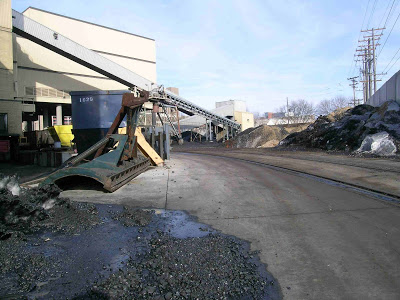by jboullion | May 1, 2009 | Uncategorized
The spring edition of RENEW’s newsletter includes the following articles:
Legislature to Tackle Wind Permitting
The Importance of Doing the Math
Stimulus Package 101
Policy Drives Solar Hot Water Market
PSC Investigates Renewable Tariffs
Open Letter from RENEW President
Calendar
by jboullion | Apr 3, 2009 | Uncategorized
From a post by Tom Content on JS Online:
The carbon dioxide catch-and-release experiment in Pleasant Prairie, which started last year, is getting some more attention today.
The We Energies power plant is the site of a project funded in part by the Electric Power Research Institute and the French company Alstom. Alstom has built a system at the state’s largest coal-fired power plant that uses chilled ammonia to separate the carbon dioxide that’s heads out into the atmosphere.
If all goes well with this test, the utility industry is planning a bigger demonstration of this technology at a coal plant in West Virginia.
Whatever technological change is forced on utilities, it won’t come cheap, Wall Street Journal Environment Editor Jeffrey Ball writes in his column today.
“Whatever the truth about ‘clean coal,’ consumers will be paying for it one way or another,” Ball writes.
The test is one way that the utility sector is preparing for regulation of greenhouse gases at some point by Congress. That’s significant for Wisconsin given how much we rely on coal for power.
by jboullion | Mar 6, 2009 | Uncategorized
From an article in The Business Journal:
Alliant Energy Corp. said Thursday that its Iowa utility, Interstate Power and Light Co., has canceled plans to construct the proposed coal-fired Sutherland Generating Station Unit 4 in Marshalltown, Iowa.
The company said in a press release that the decision was based on “current economic and financial climate; increasing environmental, legislative and regulatory uncertainty regarding regulation of future greenhouse gas emissions and the terms placed on the proposed power plant by regulators.”
The decision follows Wisconsin regulators’ denial in December of a proposed 300-megawatt expansion of the Nelson Dewey Generating Station by Wisconsin Power and Light Co., Alliant’s Madison-based utility. The Public Service Commission of Wisconsin ruled that the $1.26 billion project was too costly when weighing it against other alternatives such as natural gas generation and the possibility of purchasing power from existing sources.
In a statement, Alliant Energy chairman, president and CEO Bill Harvey said the PSC’s decision and the cancellation of the $1.2 billion-to-$1.3 billion Iowa power plant project “removes the option of adding new coal-based capacity to meet our customers’ future energy needs.”
by jboullion | Feb 12, 2009 | Uncategorized
From an article by Craig Reberth in the Telegraph Herald (Dubuque):
CASSVILLE, Wis. — Pending a state Department of Natural Resources air-quality hearing next week and the ensuing public comment period, work should start on converting a Cassville power plant from coal to 100 percent renewable fuel.
In May, DTE Energy Services, of Ann Arbor, Mich., announced it was purchasing the E. J. Stoneman power plant. DTE said it planned to convert the coal-fired plant to burn wood waste, a renewable fuel.
The Stoneman facility was built in 1950. Integrys Energy Services bought the 53-megawatt capacity plant in 1996 from Dairyland Power Cooperative and operated it as a merchant power plant, selling power in the open market. This is DTE Energy’s initial foray into Wisconsin.
Once the air permit is issued, the project will move forward, DTE officials say. The plant probably will be pulled off-line by the end of this month, with demolition and construction to take place during the summer. The plant could be back online as early as June 2010.
Work includes converting the boilers from burning pulverized coal to a stoker technology and conversion of the material handling process. It is estimated the project will use 40 people at the peak of the effort.

by jboullion | Feb 6, 2009 | Uncategorized

The Charter Street heating plant on the campus of the UW-Madison will switch from coal to biomass before the end of 2010.
From an announcement from Governor Doyle:
MADISON—Governor Jim Doyle announced today that a new biomass boiler will be installed at the Charter Street Heating Plant as part of his commitment to stop burning coal at state-owned heating plants on Madison’s Isthmus.
“We must move away from our dependence on coal,” Governor Doyle said. “This new project will help build the biomass market in Wisconsin, keep the money we spend on energy in the local economy and create green jobs in the area.”
The new biomass boiler will be capable of burning up to 100% biomass, everything from wood chips to switchgrass pellets, and will eventually be able to burn about 250,000 tons of biomass per year. This demand for biomass will help create and sustain a biomass market in Wisconsin and provide economic benefit for landowners, farmers and processors in the state.
With the switch to biomass, there will be 108,800 fewer tons of coal burned in the area each year and lower particulate emissions. Reducing particulate emissions by moving away from coal at the Charter Street Heating Plant is a key step in working to improve air quality in Dane County and moving the County back into attainment.
A media release from Better Environmental Solutions highlighted the importance of biomass production to southwestern Wisconsin:
“Planting switchgrass is a great crop for our highly erodible fields,” said Jim Schaefer, a Platteville area farmer. “We want create more markets for grass and other biomass crops for energy and fuels.”
Southwest Badger RC&D has been working with farmers and researchers on six switchgrass test plots and ways to collect woody biomass to restore native prairie and switchgrass and woodlands.
“The state’s demand for biomass will help farmers promote more conservation practices and give us cleaner water and reduced flooding,” said Steve Bertjens, NRCS Southwest Badger RC&D coordinator.

